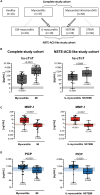Serum Concentrations of Matrix Metalloproteinase-1 and Procollagen Type I Carboxy Terminal Propeptide Discriminate Infarct-Like Myocarditis and Non-ST-Segment-Elevation Myocardial Infarction
- PMID: 38989835
- PMCID: PMC11292779
- DOI: 10.1161/JAHA.124.034194
Serum Concentrations of Matrix Metalloproteinase-1 and Procollagen Type I Carboxy Terminal Propeptide Discriminate Infarct-Like Myocarditis and Non-ST-Segment-Elevation Myocardial Infarction
Abstract
Background: Biomarkers simplifying the diagnostic workup by discriminating between non-ST-segment-elevation myocardial infarction (NSTEMI) and infarct-like myocarditis are an unmet clinical need.
Methods and results: A total of 105 subjects were categorized into groups as follows: ST-segment-elevation myocardial infarction (n=36), NSTEMI (n=22), infarct-like myocarditis (n=19), cardiomyopathy-like myocarditis (n=18), and healthy control (n=10). All subjects underwent cardiac magnetic resonance imaging, and serum concentrations of matrix metalloproteinase-1 (MMP-1) and procollagen type I carboxy terminal propeptide (PICP) were measured. Biomarker concentrations in subjects presenting with acute coronary syndrome and non-ST-segment-elevation, for example NSTEMI or infarct-like myocarditis, categorized as the non-ST-segment-elevation acute coronary syndrome-like cohort, were of particular interest for this study. Compared with healthy controls, subjects with myocarditis had higher serum concentrations of MMP-1 and PICP, while no difference was observed in individuals with myocardial infarction. In the non-ST-segment-elevation acute coronary syndrome-like cohort, MMP-1 concentrations discriminated infarct-like myocarditis and NSTEMI with an area under the receiver operating characteristic curve (AUC) of 0.95 (95% CI, 0.89-1.00), whereas high-sensitivity cardiac troponin T performed inferiorly (AUC, 0.74 [95% CI, 0.58-0.90]; P=0.012). Application of an optimal MMP-1 cutoff had 94.4% sensitivity (95% CI, 72.7%-99.9%) and 90.9% specificity (95% CI, 70.8%-98.9%) for the diagnosis of infarct-like myocarditis in this cohort. The AUC of PICP in this context was 0.82 (95% CI, 0.68-0.97). As assessed by likelihood ratio tests, incorporating MMP-1 or PICP with age and C-reactive protein into composite prediction models enhanced their diagnostic performance.
Conclusions: MMP-1 and PICP could potentially be useful biomarkers for differentiating between NSTEMI and infarct-like myocarditis in individuals with non-ST-segment-elevation acute coronary syndrome-like presentation, though further research is needed to validate their clinical applicability.
Keywords: NSTEMI; biomarker; cardiac troponin; matrix metalloproteinase‐1; procollagen type I carboxy terminal propeptide.
Figures


Similar articles
-
Differentiation of acute non-ST elevation myocardial infarction and acute infarct-like myocarditis by visual pattern analysis: a head-to-head comparison of different cardiac MR techniques.Eur Radiol. 2023 Sep;33(9):6258-6266. doi: 10.1007/s00330-023-09905-5. Epub 2023 Jul 12. Eur Radiol. 2023. PMID: 37438640 Free PMC article.
-
Procollagen type I carboxy-terminal propeptide (PICP) and MMP-2 are potential biomarkers of myocardial fibrosis in patients with hypertrophic cardiomyopathy.Cardiovasc Pathol. 2019 Nov-Dec;43:107150. doi: 10.1016/j.carpath.2019.107150. Epub 2019 Aug 28. Cardiovasc Pathol. 2019. PMID: 31639652
-
Role of thrombin generation assays in the diagnosis of acute myocarditis and non-ST myocardial infarction.J Thromb Thrombolysis. 2020 Jul;50(1):144-150. doi: 10.1007/s11239-019-01996-6. J Thromb Thrombolysis. 2020. PMID: 31754904
-
Contemporary NSTEMI management: the role of the hospitalist.Hosp Pract (1995). 2020 Feb;48(1):1-11. doi: 10.1080/21548331.2020.1701329. Epub 2020 Feb 20. Hosp Pract (1995). 2020. PMID: 31815570 Review.
-
Assessment of the Impact of Comorbidities on Outcomes in Non-ST Elevation Myocardial Infarction (NSTEMI) Patients: A Narrative Review.Cureus. 2024 Jul 28;16(7):e65568. doi: 10.7759/cureus.65568. eCollection 2024 Jul. Cureus. 2024. PMID: 39192929 Free PMC article. Review.
References
-
- Caforio AL, Pankuweit S, Arbustini E, Basso C, Gimeno‐Blanes J, Felix SB, Fu M, Helio T, Heymans S, Jahns R, et al. Current state of knowledge on aetiology, diagnosis, management, and therapy of myocarditis: a position statement of the European Society of Cardiology Working Group on myocardial and pericardial diseases. Eur Heart J. 2013;34:2648a–2648d. doi: 10.1093/eurheartj/eht210 - DOI - PubMed
-
- McMurray JJ, Adamopoulos S, Anker SD, Auricchio A, Bohm M, Dickstein K, Falk V, Filippatos G, Fonseca C, Gomez‐Sanchez MA, et al. ESC guidelines for the diagnosis and treatment of acute and chronic heart failure 2012: the task force for the diagnosis and treatment of acute and chronic heart failure 2012 of the European Society of Cardiology. Developed in collaboration with the heart failure association (HFA) of the ESC. Eur Heart J. 2012;33:1787–1847. doi: 10.1093/eurheartj/ehs104 - DOI - PubMed
-
- Ferreira VM, Schulz‐Menger J, Holmvang G, Kramer CM, Carbone I, Sechtem U, Kindermann I, Gutberlet M, Cooper LT, Liu P, et al. Cardiovascular magnetic resonance in nonischemic myocardial inflammation: expert recommendations. J Am Coll Cardiol. 2018;72:3158–3176. doi: 10.1016/j.jacc.2018.09.072 - DOI - PubMed
MeSH terms
Substances
LinkOut - more resources
Full Text Sources
Research Materials

